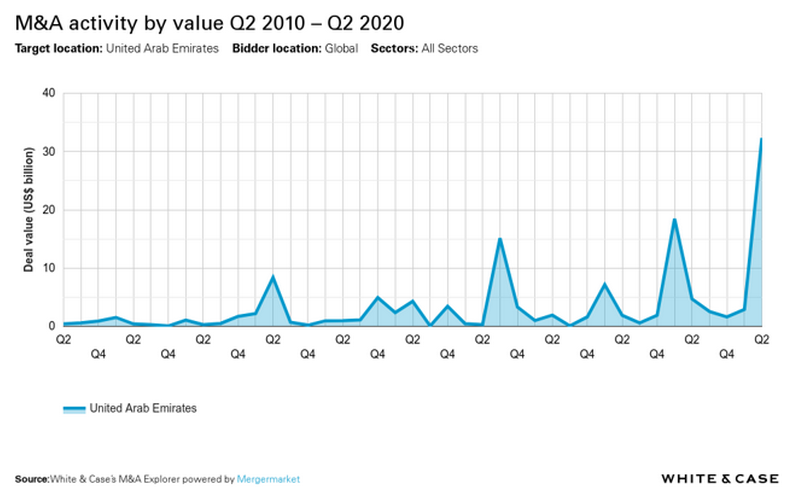
For further information, please visit the White & Case Coronavirus Resource Center.
Whilst COVID-19 continues to disrupt finance markets across EMEA, the United Arab Emirates ("UAE") has nevertheless seen a continued interest in the development of its burgeoning finance market, with M&A activity remaining strong. Following the upheaval of the global financial crisis, the UAE finance market has been dominated by a number of local financial institutions, which has tipped the market in favour of creditor-friendly terms. As those same UAE financial institutions have currently placed their focus towards portfolio management, foreign capital providers are increasingly offering support to the regional sovereign wealth offices and sponsors seeking finance.
The current landscape
Local focus on COVID-19 support
From March 2020, the focus of the UAE federal government has been to support businesses across the UAE in navigating the impact of COVID-19. The UAE has largely avoided providing direct state aid (other than in relation to Dubai's flag-carrier Emirates). Instead, the focus has been to incentivise UAE-regulated financial institutions to work alongside borrowers to minimise the potential for enforcement action and mass financing defaults.
In order to achieve this goal, the UAE implemented the Standard for the Central Bank of the UAE's Targeted Economic Support Scheme on 15 March 2020 ("TESS"). TESS is primarily aimed at providing temporary relief from the payments of principal and interest in respect of outstanding loans for all private sector companies impacted by COVID-19. Following the implementation of TESS, we have seen a substantial shift in the approach taken towards portfolio management by UAE financial institutions. Notwithstanding potential opportunities currently in the market, the underwriting of new money transactions has dropped markedly across Q2 and Q3 of 2020. During this time, UAE financial institutions have focused towards supporting legacy and key clients. Largely as a result of TESS, there have been relatively few defaults which have led to contentious enforcement outcomes on existing UAE-based financing transactions, with lenders instead demonstrating a willingness to offer lengthy waivers and extensions. That forbearance is, however, expected to be short-lived, with "space to breathe" being granted rather than a fundamental alleviation of onerous terms. As Q4 approaches, we therefore anticipate many of these corporate names will reappear in the market seeking refinancing or renewed terms that better align with their new "response to Covid-19" formulated business plans.
Whilst financial institutions within the UAE and across the GCC have been focused on supporting their existing clients and managing their accounts to seek to avoid large write-downs and the emergence of NPL portfolios, we expect a number of UAE-based corporates will widen their gaze abroad, in search of international creditors to meet their financing needs.
M&A activity continuing despite COVID-19 headwind
M&A trend data (reproduced in the table below) continues to show the UAE market exhibiting solid signs from the start of the COVID-19 pandemic. M&A activity has continued to grow within the UAE from Q2 2010, cementing the UAE as the number one jurisdiction within the GCC for overall M&A activity over the past decade. This is line with the UAE's increase in population size and demographics, and the UAE's successful bid for Expo 2020.
In the shorter term – and with the backdrop of the impact of COVID-19 – M&A activity has understandably reduced from the highs of Q2 2019, although activity across Q2 and Q3 2020 continued strongly, with several strategic transactions continuing to completion (and a number of more transactions anticipated for Q4).
M&A activity has been bolstered by a number of welcome changes of law that remove the previous legal obstacles which continued to vex many overseas investors. The UAE Cabinet's decision in July 2019 to allow 100 per cent. foreign ownership of UAE onshore entities (subject to certain restrictions), being one such change.1 This relaxation of previous extensive restrictions on foreign ownership is representative of a wider change in attitude within the UAE to encouraging foreign investment, which is anticipated to lead to increased M&A activity.
Has a shift towards creditor friendly terms created opportunities for new players?
Historically, acquisition finance transactions within the UAE (both domestic and cross-border) have relied upon regional senior bank debt, typically from key relationship banks. As a result, creditors have often been able to rely on their existing relationships to push for terms that are significantly more favourable than other regional jurisdictions.
Whilst UAE government related entities continue to obtain generally favourable market terms (often with no maintenance covenants and limited security coverage), the market for regional corporates remains far removed from the covenant-lite terms prevalent across Europe. Overseas creditors, whether financial institutions or private credit firms, may well be attracted by the characteristics and creditor friendly terms of a "market" UAE deal. In particular, transactions with regional corporates often include several of the following characteristics:
- Significant amortisation (and cash flow) on term facilities
- Extensive maintenance covenants (typically leverage, debt service, interest cover and often gearing or capex, as applicable) for the benefit of all creditors
- Creditors benefitting from extensive security and guarantee packages
- Minimal negotiated ‘permitted' concepts
A 'refresh' of security
Security coverage has always been extensive in UAE financings, with all asset security packages often buttressed with extensive corporate (and occasionally personal) guarantees. As UAE financial institutions have typically demanded extensive collateral packages, leveraged finance documents in the UAE do not typically include the comprehensive and carefully negotiated "Agreed Security Principles" contained in European leveraged finance transactions.
Notwithstanding this, previous limitations on the ability to take security over certain assets – together with lengthy court-based enforcement procedures – have resulted in the UAE having been historically viewed as a less favourable jurisdiction for secured lenders. In an effort to open up financing opportunities, the UAE implemented a series of updates to the security regime. Critically, the UAE has in recent years:
- Clarified that share pledges are able to be taken over the ownership interests in UAE limited liability companies (subject to requirements of notarisation and registration)2
- Created a regime whereby security over movable assets (including receivables, bank accounts with fluctuating balances, tangible goods, inventory and bills of lading) are able to be quickly taken and – importantly – registered in a publically searchable register
These changes (together with the ability to exercise 'self-help' remedies in certain circumstances) have drastically changed the security framework within the UAE, to the benefit of debtors and creditors alike.
The benefit of UAE free zones
The UAE also contains an ever growing number of "offshore" free zones (including the Dubai International Financial Centre ("DIFC"), Jebel Ali Free Zone and the Abu Dhabi Global Market "ADGM")) a number of which have their own laws and/or regulations. Both the DIFC and ADGM have independent regulators, judiciaries and tested insolvency regulations operating under a common law jurisdiction.
The use of UAE free zone entities within the corporate structure is a more recent feature of the UAE acquisition financing landscape, although the "friendly" jurisdictions of the Cayman Islands, Channel Islands and BVI still remain popular. We expect the use of UAE structural entities to increase since both the DIFC and ADGM now allow for holding companies to be incorporated within their jurisdiction. Combined with the familiarity of the common law regime and the fact that creditors can easily take registrable security over the shares in such entities, to those creditors familiar with English law and the English law regimes for dispute resolution and insolvency, lending under the laws of the DIFC or ADGM therefore becomes as familiar as deals being done in London.
A focus on insolvency proceedings
Prior to 2016 there was no single source of law governing insolvency proceedings within the UAE. This lack of a framework, coupled with a number of high-profile restructurings during the global financial crisis, highlighted a substantive shortfall in creditor protection within the UAE. In order to address this, the UAE Federal Bankruptcy Law No.9 of 2016 (the "Bankruptcy Law") was implemented in December 2016 with the aim to streamline bankruptcy procedures applicable to onshore UAE entities. The proceedings provided for within the Bankruptcy Law were a welcome update for creditors of UAE-based entities (particularly as they theoretically removed the need for 100 per cent. creditor approval on any restructuring). Despite this, the Bankruptcy Law remains largely untested within the UAE.
There have also been significant developments in the restructuring space within the greater UAE throughout the course of 2020, led by some high-profile names. The days of the "Majlis solution" appear to be behind us as formal processes under the onshore regime through the Financial Restructuring Committee, or offshore through the DIFC or ADGM administration processes, take centre-stage. In particular, amendments to the ADGM's insolvency regulations (which are largely based on the English law insolvency framework) have seen a number of entities commence proceedings within the ADGM. The most notable example of this is the successful application by the administrator of NMC Health plc to appoint an administrator within the ADGM in relation to the onshore UAE members of the NMC Group (and through dual incorporation into the ADGM, the onshore regulated health care companies were able to take advantage of a common law regime which was perceived to be more understood and adaptable for the benefit of the group's creditors). The potential ability to look towards the ADGM (and the DIFC) for insolvency proceedings can therefore only be a particularly welcome update for creditors evaluating UAE-based transactions.
Conclusion
The UAE financial market has seen a continued development of creditor-friendly terms for transactions relating to non-government related corporates. Notwithstanding this, we expect UAE-based financial institutions to continue to focus their attention on portfolio management whilst the UAE's COVID-19 support continues. This background – when coupled with the UAE's recent creditor-friendly regulatory updates – has rekindled the interest of a number of non-UAE financial institutions in the UAE. As UAE-based sponsors and sovereign wealth offices look to manage liquidity, the door may now be opening for foreign capital providers to enter the UAE.
1 Federal Law No. 19 of 2018 on Foreign Direct Investment provided a framework for allowing 100 per cent. foreign investment of UAE companies. The framework allows for 100 per cent. foreign ownership in relation to entities operating in certain areas (including construction, areas of healthcare, hospitality, education and agriculture), whilst businesses operating in other areas (including petroleum exploration and production, banking and financings, insurance and telecommunications) remain subject to previous requirements.
2 A UAE banking licence is required for a bank to take security by way of a share pledge, commercial mortgage (being a mortgage over inventory and goodwill (amongst other things) of a commercial business) or by way of a mortgage over land. Foreign lenders can still benefit from such security by appointing a financial institution with a UAE banking licence to hold the security as "security agent". For other forms of security (including security entered into under the New Security Law), a lender does not need to be licenced in the UAE. However, in practice, some lenders still prefer to engage a security agent to hold security over UAE assets as this is thought to be advantageous when it comes to the lengthy process involved in enforcing security.
This publication is provided for your convenience and does not constitute legal advice. This publication is protected by copyright.
© 2020 White & Case LLP


